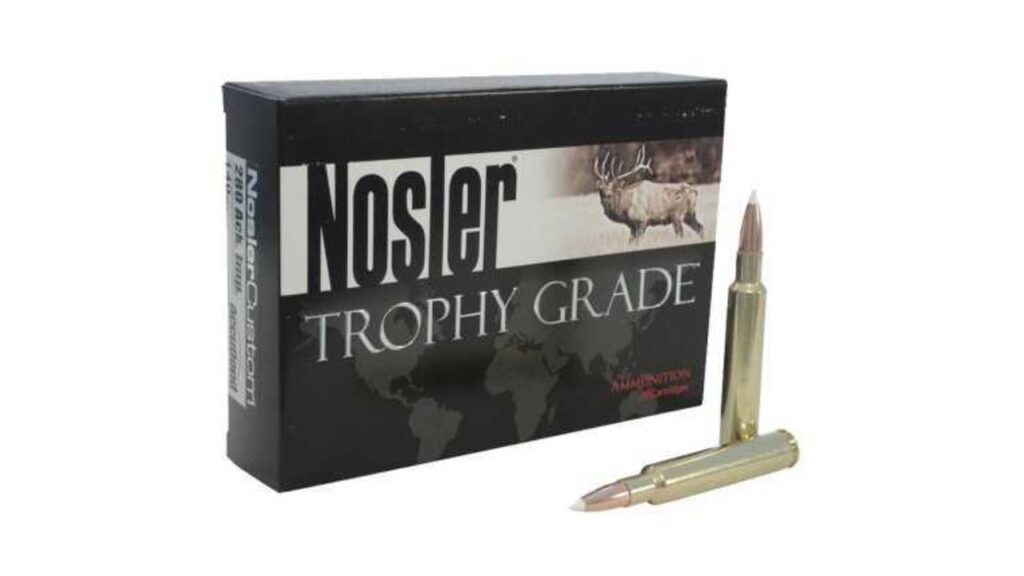Few things sting worse than hitting an animal square and watching it run off because your bullet came apart before it got the job done. Expansion is supposed to transfer energy—but too much, too soon, turns lethal hits into surface wounds. When bullets expand too early, they lose penetration, fail to reach vital organs, and sometimes don’t even exit, leaving you with a poor blood trail and a long night of tracking.
Hunters who shoot high-velocity rifles see this more than anyone. Certain bullet designs simply can’t handle impact at magnum speeds or close-range shots. They break apart on bone, mushroom too fast, and stop short of where they need to go. These are the bullets that have left more than a few elk, deer, and antelope hunters frustrated in the field.
Nosler Ballistic Tip

The Nosler Ballistic Tip is known for accuracy, but it’s also notorious for violent expansion at high velocity. On smaller deer or pronghorn, it performs beautifully, dropping animals fast. But when used on heavier game like elk or at close range with magnum calibers, it tends to explode on impact. The thin jacket and polymer tip initiate expansion instantly, often before the bullet has penetrated deep enough.
The result is massive surface trauma and poor internal damage. Hunters often report shallow wound channels and lost animals after what felt like perfect hits. It’s an excellent bullet within its limits, but it’s not built for heavy bone or high-speed impacts. If you’re shooting a .300 Win Mag or anything similar, the Ballistic Tip can cause more heartbreak than clean kills.
Hornady SST

The Hornady SST (Super Shock Tip) was designed for speed and expansion, but it’s overly aggressive when it meets close-range impacts. Hunters love its flat trajectory and accuracy, but many have seen it fragment on shoulder shots, leaving poor penetration. The thin jacket and high ballistic coefficient make it perfect for long-range deer—but devastatingly fragile up close.
In magnum cartridges or high-velocity .270s and .30-06s, the SST can over-expand, dumping all its energy too soon. On lighter game, that might not matter, but on elk or moose, it’s a recipe for disappointment. The bullet works best past 300 yards where velocity drops, but most big-game encounters happen much closer. It’s accurate and deadly—until it hits too hard, too fast.
Winchester Deer Season XP

Winchester’s Deer Season XP gained a quick following because of its precision and devastating expansion—but that “devastation” is its own downfall on big game. The oversized polymer tip and thin jacket cause it to open up almost instantly. On whitetails at modest velocity, it’s effective. On heavier game, or at close ranges, it fragments before it penetrates deeply enough.
Hunters have found that broadside shoulder hits often leave shallow craters instead of clean wound channels. The bullet’s lightweight construction simply can’t withstand high-impact velocities. It’s designed for speed and shock, not for controlled penetration. While it’s great for typical deer country, it’s not the round you want when elk, mule deer, or moose are in front of your crosshairs.
Federal Fusion

Federal Fusion bullets use electrochemical bonding, but despite the marketing, they still expand too aggressively at higher impact speeds. At moderate ranges, they perform well. Inside 150 yards, especially with magnum calibers, they can mushroom to near flat discs within inches of entry. That expansion limits penetration, leaving hunters with surface hits and incomplete energy transfer.
While Fusion bullets are accurate and consistent, their soft cores and thin forward jackets make them too fragile for close shots on large animals. Hunters often report poor blood trails when shoulder bones are hit, as the bullet tends to shed too much mass. They’re fine for standard deer loads, but when magnum velocity or heavy bone enters the equation, Fusion ammo falls short.
Hornady ELD-X

The Hornady ELD-X is marketed as a do-it-all bullet, but hunters have found it can expand prematurely at short range. Its Heat Shield tip initiates expansion aggressively, and the soft jacket forward section can’t always handle high-velocity impacts. The result is a bullet that performs beautifully at long range but too violently up close.
On elk or moose, especially within 150 yards, the ELD-X can lose too much weight too soon, leading to shallow penetration. Hunters have documented fragmented projectiles on shoulder hits where deeper penetration was critical. It’s accurate, aerodynamic, and lethal—when used correctly. But inside typical hunting distances, it’s been known to behave more like a varmint round than a big-game bullet.
Nosler AccuBond LR

The AccuBond LR was designed for extreme-range performance, but its thin jacket and rapid expansion characteristics cause problems on closer encounters. At long distances, it opens reliably and transfers energy perfectly. But when impact velocity is high, it expands too quickly and sometimes sheds most of its mass.
This early expansion limits penetration on larger animals, especially when shots connect with heavy bone. Hunters shooting fast cartridges like 28 Nosler or 300 PRC have seen bullets come apart on broadside hits inside 200 yards. It’s a precision bullet made for specific conditions—those long western shots—but it’s not versatile enough for every hunting scenario. Inside normal hunting ranges, it’s simply too soft.
Sierra GameKing

The Sierra GameKing has been a trusted bullet for decades, but it’s not immune to premature expansion. The thin-jacketed design excels on soft tissue but breaks apart when it meets heavy bone at high velocity. On smaller deer, it’s perfect; on elk or moose, it often fails to penetrate deep enough for a clean kill.
Hunters using magnum calibers report seeing devastating surface damage with little internal trauma. The GameKing’s rapid expansion can cause a shallow wound that closes up quickly, leaving minimal blood to track. It’s a fine bullet for light to medium game, but its old-school construction can’t keep up with modern cartridge speeds. When you push it too hard, it comes apart too fast.
Winchester Power-Point

Winchester’s classic Power-Point has taken plenty of deer, but its cup-and-core construction means it expands too readily under modern high-velocity conditions. The soft lead tip and thin copper jacket cause instant mushrooming, often before the bullet reaches vital organs. On big-bodied game, this can result in poor penetration and lost animals.
It’s an affordable and accurate round for standard calibers, but when pushed fast through modern cartridges like the .270 WSM or .300 Win Mag, it simply can’t hold together. Hunters who rely on one-shot stops often find themselves tracking wounded animals after perfect broadside hits. It’s an old design that struggles to keep up with today’s faster rifles.
Remington Core-Lokt

The Remington Core-Lokt is a deer-hunting classic, but its rapid expansion can work against you when used on large or close-range targets. The soft lead core and traditional jacket bond give it great energy transfer, but very little weight retention. On thin-skinned game, it’s fine. On elk or moose, it often comes apart on impact.
Hunters have seen bullets fail to exit or fragment under the shoulder, leaving minimal penetration. While newer bonded versions have improved this, the standard Core-Lokt has always expanded fast—too fast in magnum rifles or at close distance. It’s reliable in accuracy but inconsistent in terminal performance when too much velocity is involved.
Norma Whitetail

Norma’s Whitetail line is built for light- to medium-sized game, and its soft-point bullet reflects that. It expands quickly and transfers energy efficiently, but it lacks the structural integrity for larger animals or high-velocity cartridges. When impact speeds exceed 2,800 feet per second, it mushrooms almost immediately.
This limits penetration and creates shallow wound channels that often fail to reach vital organs on elk or bear. Hunters who’ve used it on heavier game frequently report poor performance even with solid shot placement. It’s an excellent whitetail round—but it’s too soft for anything tougher. When pushed beyond its intended range, it’s a bullet that gives up too early.
Hornady InterLock

The Hornady InterLock has been a reliable hunting bullet for generations, but it shows its limits when driven fast. Its mechanical “interlock” ring helps retain some weight, but the thin jacket and soft lead nose still make it prone to over-expansion. On big game or close shots, the bullet flattens too quickly and sheds mass before reaching the vitals.
It performs admirably in standard .30-06 or .308 loads, but when loaded in faster cartridges like the 7mm Rem Mag or .300 WSM, it’s too soft. Hunters have seen bullets fragment on shoulder hits that should’ve anchored the animal. It’s a classic bullet that still has a place—but not in magnum rifles or on thick-skinned targets.
Speer Hot-Cor

The Speer Hot-Cor is accurate and consistent, but its unbonded construction makes it vulnerable to premature expansion. The soft nose and thin jacket let it open fast, which can be disastrous on close-range shots with modern, high-speed cartridges. On deer-sized game, it’s usually fine—but on elk, it’s often not enough.
Hunters have seen Hot-Cor bullets blow up on bone, creating massive entrance wounds and shallow internal damage. It’s an affordable bullet with proven accuracy, but it simply can’t maintain structure at magnum velocities. While it’s great for mild cartridges or smaller animals, it’s one of those bullets that expands too quickly when you need it to go the distance.
*This article was developed with AI-powered tools and has been carefully reviewed by our editors.






